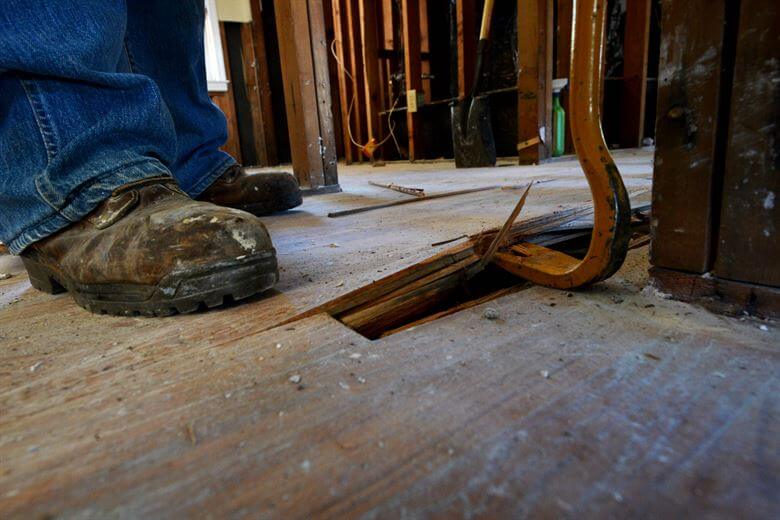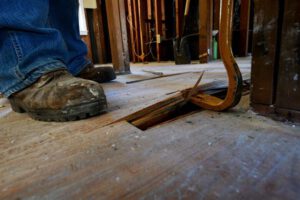Hardwood Floor Replacement: Is It Time to Replace Your Floors?

If your hardwood floors are showing signs of wear, such as dings, scratches, or fading, it might be time to consider replacing them. Depending on the extent of the damage, this may or may not be a more economical option than repairing and refinishing them.

Before making the final decision, it’s important to research your options and consider all of the factors that affect Hardwood Floor Replacement costs.
The cost of hardwood floor replacement can vary significantly, depending on a number of factors. The price of the flooring itself, labor costs, and any other associated expenses are just a few of the things that go into the overall project.
When it comes to the material itself, there are three main categories that determine how much a hardwood floor will cost: softwoods like pine, mid-range wood flooring options like oak or cherry, and exotic options such as tigerwood, mahogany, or Brazilian walnut. Typically, softwoods and mid-range flooring will cost around $3 to $6 per square foot for the flooring itself, while high-end options can run between $5 and $10.
Preparation before installation will also affect the total price. If a contractor needs to level the subfloor or trim baseboards, this will add to the cost of the job.
If you’re planning to refinish existing floors, the cost will depend on how many coats of stain and finish you’re going to need. The type of wood being refinished will also have an impact on the cost as well as the difficulty of the job.
Refinishing a hardwood floor can be a great way to increase your home’s resale value, improve the aesthetic appeal of your space, and extend the life of your flooring. However, the price of refinishing can vary considerably, and it may be best to talk to professionals about the process before making a final decision.
For instance, a professional flooring contractor will be able to offer you a variety of different hardwood flooring options, including the option to select an engineered floor that will be more affordable and easier to install. This will help you keep the cost down as well as the time it takes to complete the project.
When it comes to the maintenance of your new hardwood floor, you should make sure to dust and vacuum daily. This will ensure that your new flooring stays clean and free of any dirt and debris that can damage the surface over time. You should also avoid allowing water to pool on your floors, as this can cause damage and lead to mold growth.
Installation
When it comes to replacing your floors, it’s important to get the job done right. It’s not just about the look of the new floors; it’s also about the safety of your family and property.
You should be sure that the contractor you hire can complete the installation correctly. A bad installation can damage the wood, cause warping, and cause other problems that aren’t good for your home or your family.
Generally, professional hardwood flooring contractors have the expertise and experience necessary to make sure that your floor is installed properly. In fact, they may even be able to recommend the best type of wood for your project.
A hardwood floor is a long-lasting and stylish addition to any home. It adds a sense of warmth and sophistication that can help increase the value of your home, so you want to choose the flooring that’s right for your space.
Before the flooring can be installed, it must acclimate to your area’s temperature and humidity levels. This can take anywhere from two days to several weeks, depending on the climate where you live and the type of wood you’re using.
This process is essential for a solid wood floor to last and look its best, so you’ll need to give your floor time to adjust. This can be a difficult task for some homeowners, so if you’re not comfortable with the installation, you may want to ask a professional hardwood flooring contractor to help you out.
Another thing you need to do before installing your hardwood floors is ensure that the subfloor has been sanded and leveled. You should also use a vapor barrier, such as red rosin paper, felt, or foam. This is an important step because it’s a key step in preventing moisture from escaping from the subfloor and damaging the flooring.
Then, you’ll need to remove any existing baseboards and trim, as well as shoe moldings and doors. This allows the new floors to be installed as close to the walls as possible, creating a seamless look.
Finally, you’ll need to use a face nailer to secure the first few boards in place. This is the method traditionally used by professional flooring installers.
Maintenance
If you have hardwood floors, you’ve probably heard the old adage that “maintenance is key.” Hardwoods are beautiful and long-lasting, but they require regular care to maintain their natural appeal.
A simple routine of dust mopping and vacuuming daily is the best way to keep your hardwood flooring clean and in good shape. Be sure to use a dedicated microfiber floor mop and not a general-purpose cleaning mop with beater bars because those types of mops can scratch the finish on your wood flooring.
Depending on the level of traffic in your home, you may need to sweep or vacuum every day or twice a week. A weekly mop is also recommended to remove any dirt and grime from the surface of your hardwoods.
Regular maintenance will help prevent fading and scratching on your hardwood floors, and it will help you avoid the need to replace them entirely. If your wood floors start to show signs of wear and tear, it’s time to call in the pros.
The first step to take when considering hardwood floor repair is to look for the telltale signs of damage, including warping, buckling, and cracked or sagging boards. In many cases, these problems can be repaired without the need for replacement, but in some instances, it’s necessary to replace the entire floor.
Squeaking is another issue that you’ll need to consider, as squeaky floors are a sign of loose or warped joists under the hardwood. Loose joists can cause planks to rub against each other, and the fasteners that hold the flooring in place can become loose or damaged.
It’s important to address squeaky floors immediately because this can lead to more serious issues if not fixed. Squeaky floors can also be a sign of termites, and you should get them dealt with as soon as possible to prevent more serious damage to your floor.
You can also prevent squeaky floors by keeping your floors swept and vacuumed frequently and avoiding bringing large items into the room, such as furniture. Rugs and fabric pads on the feet of chairs and furniture can reduce the impact of foot traffic on your hardwood floors.
Style
Hardwood floors have an elegant look and feel that make them an excellent choice for many home designs. They also last a long time and are extremely durable. But like any material in a house, hardwood flooring will eventually need to be replaced.
If you want to replace your floors, it’s best to hire a professional flooring contractor to handle the job for you. They’ll know all the tricks of the trade, and they can help you pick the best style for your needs and budget.
One of the easiest ways to save money on a new hardwood floor is to shop around. There are plenty of options to choose from, including solid wood, engineered wood, and laminate.
Laminate is a popular alternative to hardwood, as it looks much like real wood and is often more affordable. It’s available in several different colors and styles, and you can get it pre-finished or unfinished.
Engineered wood is also a good option, as it’s more resistant to moisture and doesn’t warp as quickly as solid hardwood. But it may not be suitable for areas that experience a lot of water, such as bathrooms or basements.
Another type of flooring that can save you money is bamboo. This eco-friendly, fast-growing option is easy to install and is a great alternative to real wood.
A hardwood floor replacement is a great way to improve your home and add value at the same time. But it’s not a cheap project.
The cost of a hardwood floor replacement depends on the material you’re replacing, the type of installation, and whether you need to hire a professional contractor. It also depends on the size of your house and how much it costs to remove old flooring.
It’s important to find a local flooring company that can offer you the best discounts and promotions. Some companies even offer free consultations.
In addition, you’ll want to ask about warranties and how long they’ll cover the product. Some brands will give you a warranty that covers the materials and labor for the first 10 years.
